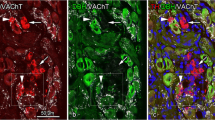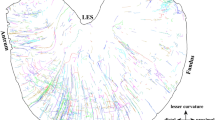Summary
The chemical nature of the spinal ganglionic neuron with peripheral processes projecting divergently to the somatic and visceral areas, has been identified by means of tri-labeling method of combining fluorescein tracing with immunocytochemistry. 10 rats were used. First, 2 μ1 of 2% fast blue(FB) were injected into the left coeliac ganglion. Two days later, 2% nuclear yellow (NY) was injected into left 9–11 intercostal nerves, 1 μ for each. On the 4th day, the animal was perfused with 10% formal in in 0.1 mol phosphate buffer. The left T9–11 spinal ganglia were removed and cut into sections by cryostat. The sections were observed under fluorescence microscope and photographed. The results showed that there were three kinds of neurons in the spinal ganglia; 1) single FB labeled cells with blue fluorescent cytoplasm accounted for 38.8% of total cells; 2) single NY labeled cells with yellow fluoresceent nuclei accounted for 52.796; 3) FB and NY double-labeled cells, mostly small or medium in size, accounted for 8.5%. Then, the sections containing doublelabeled cells were further processed by substance P-demonstrating PAP immunocytochemical staining. The photographs with immunostaining and fluorescein labelings in the same section were compared. We found that the labeling ratio of SP/NY was 1.4%, SP/FB was 7%, and SP/NY+FB was 28.8%. The present study detected not only the convergence of somato-visceral sensation in the spinal ganglia but also the chemical nature of these neurons containing substance P (SP) for the first time. In addition, these results may provide a morphological basis for the mechanisms of referred pain and somato-visceral reflection.
Similar content being viewed by others
References
Langford LA, Coggeshall RE. Eranching of sensory axons in the dorsal root and evidence for the absence of dorsal root efferent fibers. J Comp Neurol 1979;184: 193–204.
Langford LA, Coggeshall RE. Branching of sensory axons in the peripheral nerve of the rat. J Comp Neurol 1981; 203: 745–50.
Bahr R, et al. Do dichotomizing afferent fibers exist which supply visceral organs as well as somatic structures? A contribution to the problem of referred pain. Neurosci Lett 1931:24:25–8.
Pierau F-K, et al. Dichotomizing peripheral fibers revealed by intracellular recording from rat sensory neurons. Neurosci Lett 1932;31:123–8.
Taylor DCM, Pierau F-K. Double fluorescence labelling supports electrophysiological evidence for dichotomizing peripheral sensory nerve fibers in rats. Neurosci Lett 1982;33:1–6.
Pierau F-K, et al. Somato-visceral convergence in cat dorsal root ganglion neurons demonstrated by double-labelling with fluorescent tracers. Brain Res 1984;321:63–70.
Sternberger LA. Immunohistr. Biochemistry. 2nd ed, New York, Wiley 1979;104–69.
Sawchenko PE, Swanson LW. A method for tracing biochemically defined pathways in the central nervous system using combined fluorescence retrograde transport and immunohistochemical techniques. Erain Res 1981;210:31–52.
P -HRP 1985; 1:21–4.
Chen-Palay V. Combined immunocytochemistry and autoradiography. In vivo injections of monoclonal antibodies and radioactive amines (substance P and H-serotonin). In: Techniques in Neuroanatomical Research. Heym Ch, Forss-mann M-G, eds. Berlin, Heidelberg, New York, Springer, 1981:255–63.
Hokfelt T, et al. Combination of retrograde tracing and neurotransmitter histochemistry. In: Handbook of Chemical Neuroanatomy vol. 1, Bjorklund A, Hok-felt T, eds. New York, Elsevier, 1983.
Piercey MF, Schroeder LA. Sensory and motor function of spinal cord substance P. Science 1981; 214:1361–3.
SP 1986; 2:71–8.
Dalsgaard C-J, et al. Substance P-containing primary sensory neurons projecting to the inferior mesenteric ganglion: Evidence from combined retrograde tracing and immunohistochemistry. Neuroscience 1982;7:647–54.
Gibson SJ, Polak JM. Neurochemistry of the spinal cord. In: Immunocytochemistry. Polak JM, Norden SV, eds. New York, Wright Bristol, 1986:360–89.
Author information
Authors and Affiliations
Rights and permissions
About this article
Cite this article
Qing-ying, L., Chang-geng, Z. The somato-visceral divergent projections of peripheral processes of substance p-containing spinal ganglionic neurons-tri-labeling study of combining fluorescein tracing with immunocytochemistry. Journal of Tongji Medical University 9, 216–221 (1989). https://doi.org/10.1007/BF02909086
Issue Date:
DOI: https://doi.org/10.1007/BF02909086




